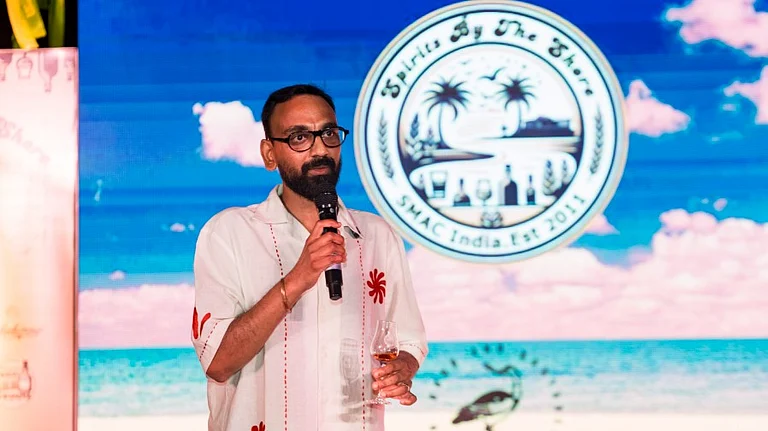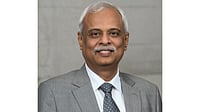It was 1971 and a young graduate stood at a crossroads in Bengaluru. With a fresh degree from University Visvesvaraya College of Engineering, Prahlada Rama Rao had two paths ahead, take up a job or pursue higher studies. It was his mother who tipped the scales.
“She said I should go for my master's and I’m glad I listened,” he recalls. That decision led him to the Indian Institute of Science (IISc), where he joined the aerospace development department and chose to specialise in rockets and missiles, a choice that would shape not just his career but also the future of India’s defence sector.
“There were many domains in aerospace like propulsion, airframe structures, aerodynamics, radar and flight control. But I was always drawn to rockets and missiles,” says Rao. At a time when India’s indigenous missile capabilities were still in their infancy, he was already preparing himself to be at the heart of it.
Even before completing his course, he visited the Indian Space Research Organisation (ISRO) facilities and the (Defence Research And Development Organisation) DRDO laboratories. By 1971, he had a job offer from ISRO and moved to Thiruvananthapuram, eager to contribute to India’s growing space ambitions. But soon, a second offer arrived, this time from DRDO.
“They reminded me I had received a scholarship from them, so in a way, I was duty-bound to join. That’s how I landed in Hyderabad,” he says.
Thus began his early immersion into India’s missile ecosystem, working across sub-systems and learning hands-on about anti-tank, surface-to-air and surface-to-surface missiles. Four years later, he moved to the Aeronautical Development Establishment (ADE) in Bengaluru, to be closer to his parents.
The Early Years
When APJ Abdul Kalam walked briskly into the Defence Research And Development Laboratory (DRDL) in Hyderabad in the early 1980s, Prahlada wasn’t expecting the quiet encounter to shape the trajectory of his life. “He came with my then-director, introduced himself and shook hands with everyone in the lab,” recalls Rao. “I was just one among a hundred scientists in the room, but he made it a point to meet each of us.”
Though both men had been placed in Thiruvananthapuram; Kalam leading critical space projects and Prahlada engaged in lab-based R&D, their professional paths hadn’t crossed until then. But that meeting would mark the beginning of something far greater.
By 1983, as the government began contemplating an indigenous missile programme, a missile policy committee was formed with APJ Kalam as a central figure. Prahlada and his team were called upon to contribute ideas, particularly in system modelling and simulation. “He was very keen on understanding how missiles behave in theoretical conditions, not just hardware. I used to talk to him about missile system modelling and over time, those conversations became more frequent,” he says.
A year later, in 1984, the Indian government gave formal approval to what would become a landmark in India’s defence history, the Integrated Guided Missile Development Programme (IGMDP). Four strategic projects were sanctioned and DRDL was given the mandate to lead from the front. The financial backing came with considerable freedom: a lump sum of ₹350 crore, an astronomical figure at the time, was handed directly to the programme, allowing scientists to move with unprecedented autonomy.
It was during this time that Prahlada was appointed project director of Akash, one of the four missile systems under the programme. He was only 35. “I was relatively young compared to the other project directors,” he admits. “We started with just five people. Eventually, it became a team of fifty.”
With scale came responsibility, budget distribution, manpower allocation, lab coordination and everything flowed through him. “We had to ensure that the funds and tasks were synchronised across 12 partner laboratories, from Bangalore and Chennai to Pune and Chandigarh. The money came into DRDL and it was my job to allocate and monitor it,” he says.
The freedom was absolute and so was the accountability. “As project director, you get all the authority be it administrative, financial, technical. And if anything goes wrong, it’s your name on the line. If it goes right, you get a ‘shabash’. If not, well, you carry the bag,” he laughs.
It was a high-stakes role in a high-pressure environment. But for Prahlada, it was the kind of challenge he had been unknowingly been preparing for since his days at IISc.
Missiles, Mentors and Moving Cities
While the world was mostly unaware, there were about the five core missile systems under the integrated guided missile development programme (IGMDP)—Trishul, Akash, Nag, Prithvi and Agni. But two more initiatives were eventually added: the submarine-launched K-15 missile and the Indo-Russian collaboration, BrahMos. In one way or another, Prahlada found himself woven into all seven.
“All the five projects came under Dr Kalam as the programme director,” Prahlada says. “But he had a unique way of identifying people he trusted, people he knew would rise to the occasion. And I was fortunate to be one of them.”
His involvement often began with a call that sounded casual but carried the weight of national urgency.
“For Prithvi’s first launch, he told me, ‘Prahlada, come and join the team.’ I said, ‘Sir, I’m already neck-deep in Akash.’ He replied, ‘Just for a few days. Your presence will make a difference.’”
And so, he went to Sriharikota ISRO’s launch site, not DRDO’s usual Balasore range. For fifteen days, he embedded himself with the Prithvi team, solving problems, building confidence and standing by for the launch.
His absence from Hyderabad didn’t go unnoticed.
“My Akash team was upset,” he laughs. “They said, ‘Sir, we’re waiting for your direction.’ But Kalam always believed I could solve problems. He had that trust in me.”
That trust extended to Agni, a project of even greater complexity. Kalam once again summoned him to Balasore, this time for an entire month.
“I was gone so long, my team was frustrated. My wife wasn’t happy. My daughter barely saw me. But I also learnt so much from being on the ground with Agni. Every missile had a different personality; Agni was nothing like Akash.”
What was remarkable wasn’t just his technical fluency across, but the speed at which he adapted to unfamiliar domains. One such case stands out: the naval self-propelled underwater missile torpedo programme in Visakhapatnam.
“One day, Kalam called and said, ‘I want you to go to NSTL [Naval Science & Technological Laboratory] in Vizag.’ I asked, ‘What for?’ He said, ‘They’re having trouble with a torpedo system. It’s not picking up speed after being launched into the ocean.’”
Prahlada was baffled but not for long.
“I told him, ‘Sir, I’ve never even seen a torpedo.’ He just said, ‘No, you go. I know you can handle it.’”
That vote of confidence became a hallmark of their relationship. At NSTL, he studied the problem, diagnosed the flaws and helped the team engineer a turnaround. “Eventually, we got the torpedo to behave the way it was meant to. The lab director and the project team were thrilled.”
Wherever there was a roadblock, Kalam would send him not just as a scientist, but as a crisis manager, systems thinker and motivator.
“It wasn’t just about missiles,” he reflects. “It was about solving tough problems. Kalam had that sixth sense, he could see not just what you were doing, but what you were capable of.”
Bearing the Burden with Kalam’s Push
Taking charge of India’s first-ever complete missile system was no small feat. Rama Rao recalls the immense pressure of stepping into a role with little precedent not just in India, but globally.
“I kept wondering, can I really fit into these shoes?” he reflects. “Big aerospace companies in the US and Europe have been developing missile systems for 50 or even 100 years. We were complete novices.”
The challenge was staggering. He was responsible for managing vast sums of money, a diverse team spread across multiple laboratories nationwide and coordinating with senior military officers and scientists, some more experienced than others.
“It was a huge job,” he says. “You deal with all sorts of people: army, air force officers, senior and junior scientists. I had to explain things, make sure everyone understood the complexity of what we were doing.”
Yet through the uncertainty and complexity, one constant stood out is the unwavering support of Dr Kalam.
“Kalam was behind me every step of the way. I treated him like my elder brother, my mentor. When the weight of the workload was crushing, he was my pillar,” Prahlada recalls.
Others doubted India’s capability to build such a complex missile system. The scepticism was loud: “They thought this was too big a problem, too complicated, and that India would never succeed.”
But the Indian armed forces demanded the best. “The army and air Force told us, ‘Give us a missile that is no less than the best in the world, Russian, French or American. It should be at par.’ That was our benchmark.”
Amidst this intense pressure, APJ Kalam’s faith in him never wavered.
“If I faced a dilemma, should I take route A or route B? I’d go to him for guidance. He was always there, supporting and believing this project would succeed.”
Their collaboration extended far beyond formal meetings. When in Delhi for headquarters discussions, they stayed at the same guest house in Asiad Village. It was during late-night walks there that their bond deepened.
“We’d finish dinner, and he’d say, ‘Let’s go for a walk.’ Around 10 pm, we’d stroll and discuss everything from technical challenges, management issues, leadership. That’s where I learned a lot, not just as a scientist, but as a human being.”
He describes Kalam’s leadership style as patient and unwavering.
“No matter how many failures we faced, ground tests, simulations, flight trials Kalam was never upset. I faced 40 to 50 failures during testing, but he stood firmly behind me.”
That steadfast trust and mentorship made all the difference, transforming daunting challenges into achievable milestones.
Building From Scratch
For nearly a decade, two components of the missile system kept Rama Rao awake at night: a sophisticated phased-array radar and the rocket ramjet-propulsion system. Both were firsts for India and unmatched in complexity even by global standards at the time.
“We were developing the most advanced radar ever attempted in the country,” he recalls. “It had to simultaneously conduct surveillance, track multiple targets and guide missiles in real time, powered by massive software systems. No other radar was as complex when we started.”
The radar development was led by the electronics and radar development establishment (LRDE) in Bengaluru and the challenges were relentless. “Accuracy issues, integration delays, software mismatches took almost ten years,” he says. “The LRDE team was excellent, but there was no one to handhold them. They had to build it all from scratch.”
Meanwhile, the rocket ramjet propulsion system brought its own set of technical hurdles. Together, these two elements stretched timelines, but by the mid-1990s, the missile system was functional.
Rigorous testing followed, often in tough coastal conditions at Balasore, Odisha. Over the next five years, the missile system was flight-tested more than 20 times. When the army and air force were finally convinced of its maturity, they initiated a crucial phase: user trials.
“The user said, ‘Test three missiles in the following configurations. Show us three successful launches within a few days,’” Prahlada explains. “That was the most critical stage. Thankfully, all three tests were successful.”
But even that wasn’t the end. The military posed new tactical scenarios: What if the enemy suddenly appeared within a few kilometres, could the missile intercept at close range?
This required rapid modelling, software tweaks and intensive ground testing. “Finally, we demonstrated that a target could be intercepted within 3–5 km,” he says. “The army and air force told us they had never seen such a close-range interception demonstrated even systems bought from France or Russia hadn’t shown that.”
That moment was a turning point. With successful demonstrations complete and confidence running high, the focus shifted to production. Bharat Dynamics (BDL) in Hyderabad handled missile systems and launchers, while Bharat Electronics Ltd (BEL) in Bangalore took charge of radars and control systems.
“Nearly 200 MSMEs across India became part of the supply chain,” says Prahlada. “The production challenge was huge: mechanical, electrical, software, quality control, integration. But BDL and BEL stepped up. They even improved on designs, interfaces and assembly within their capacities.”
He cites a key example of adaptation: “The air force version was built on one type of vehicle. When the army requested a more rugged version for harsh terrains, the teams re-engineered the radar, launcher, and control systems to fit the new vehicle with minimal hand holding from DRDO.”
Such collaboration between DRDO and public sector manufacturers eventually laid the foundation for international confidence in the Akash system.
“We’ve now supplied Akash to the Philippines and Armenia. Two more countries are in the pipeline,” he shares. “This level of maturity in production gives other nations confidence. DRDO can’t handle the business side but BDL, BEL and our private partners are ready.”
To ensure long-term support, DRDO has retained a small, embedded team. “They remain involved, guiding the production teams where necessary without slowing them down. That’s the model that works.”
A Life Engineered by Purpose
Despite having lucrative options in academia, the private sector or even opportunities abroad, Prahlada Rama Rao never once second-guessed his decision to join DRDO.
“Never,” he says without hesitation. “In fact, I still propagate that DRDO is a wonderful place if your mind is creative and innovative. If you want to think of new things, build new technologies and products, this is the place.”
For him, the excitement never waned. “In 45 years, I never got bored even for a single day. Everything we did was new, attempted for the first time. If it doesn't work, you break your head and try again. When it works, the joy is immense.”
What particularly drew him in was the sheer diversity of challenges, developing missiles, radars, propulsion systems and more often with no precedents to fall back on.
Prahlada explains how DRDO fits within the broader framework of India’s Ministry of Defence (MoD), a structure that places distinct responsibilities across departments. “The MoD has four major functional arms,” he says. “First, the defence public sector units like BDL, BEL, HAL [Hindustan Aeronautics] handle manufacturing. Second, the Services like army, navy, air force, coast guard. Third, DRDO, which handles all the R&D. And the fourth is administration and pensions.”
He emphasised that DRDO’s mandate is strictly development. “They expect DRDO to take up every major defence development from ideation to prototype. Once it's proven, it moves to the PSUs for mass production. That clarity of role is what makes DRDO an ideal place for researchers who want to build top notch systems.”
It’s this alignment between vision, freedom and national service that kept him motivated for nearly half a century.
A New Frontier in National Service
After a decorated career culminating in the Padma Shri, many might have expected Prahlada Rama Rao to retire quietly. Instead, he chose to venture into one of the most controversial and least understood domains in science: Low-Energy Nuclear Reactions (LENR), also known as cold fusion.
“Actually, I didn’t even know what a low-energy nuclear reaction was,” he admits candidly. The turning point came in 2012, when a call from APJ Abdul Kalam changed the course of his post-retirement life. “Dr Kalam called me one day and said, ‘you come.’ He introduced me to a deputy director at BARC [Bhabha Atomic Research Centre] and told me, ‘Srinivasan wants you to take up research on a new form of energy.’”
At first, he hesitated. “I told him, ‘Sir, I’ve never worked in fuel or energy. I know bombs, rockets, torpedoes, missiles.’” But Kalam’s unwavering confidence pushed him forward. “The trust he had in me, probably not even my family members had that kind of trust. I’ll always be indebted to him.”
Thus began a 13-year-long journey into the uncharted waters of cold fusion. Working out of a modest facility in Jigani, Bangalore, his team encountered repeated failures. “Whatever we did, nothing was happening. But we kept at it.”
Their perseverance paid off. “After 12 years, we got reasonably good results, results that were on par with what’s being seen in the US, China and Japan,” he says. “These are the three leading countries in LENR research. Now, we are the fourth.”
What makes the achievement remarkable is India’s frugal approach. “Our investment was maybe one-tenth of what they’ve spent. But our results are equally strong.”
Now, he and his team are preparing to take the technology to market. A startup called Hylenr has been established in Hyderabad and they are actively seeking investors. “We’re expecting some funding to come in June 2025, which will help us scale up operations.”
Hylenr, a Hyderabad-based startup incubated at T-Hub, has developed a patented Low Energy Nuclear Reactor (LENR) that employs cold fusion to generate clean energy. The reactor utilizes nickel, palladium, and hydrogen to initiate a fusion process without radioactive materials, achieving a 1.5x heat amplification producing 150 watts of heat from 100 watts of electrical input.
This innovation has applications in space missions, steam generation, room heating, and industrial induction heating. Hylenr has partnered with space-tech firm TakeMe2Space to test LENR-powered modules in space, aiming to provide compact, long-lasting energy sources for satellites. The company is seeking $10 million in strategic investments to scale production and enhance efficiency, with plans to increase power output to 2.5 times the input energy. Hylenr's technology has been granted a patent by the Indian government's Patent Office under the Department for Promotion of Industry and Internal Trade (DPIIT).
The team is also appealing to both the central and state governments including Andhra Pradesh, Telangana and Karnataka for funding support. “This is not a DRDO requirement, it’s a national need. We’re talking about the future of energy for the entire country.”
Lessons for the Next Generation
As he reflects on his journey, his message for the next generation of scientists is one of conviction, collaboration and clarity of purpose. When asked what he hopes a young scientist, two decades from now, will take away from his life’s work, he doesn’t hesitate.
“If your fundamentals are strong physics, chemistry, mathematics then nothing is impossible. You can do anything you want in any subject you want.” That belief, rooted in decades of scientific rigour and nation-building, continues to define his interactions with students and young researchers today.
Yet, technical depth alone isn’t enough. He emphasises the importance of collaboration and leadership. “One person cannot do anything. I had to work with a thousand scientists to make Akash work. You must learn how to interface with people, earn their respect through knowledge, clarity and purpose.”
He urges young scientists to build what he calls their own “template” a blueprint for impact. “Leadership in technology, leadership in management and sound fundamentals. If you have these, people will follow you.”
He also sees young Indians as central to the country's future. His faith in their potential is unwavering. “India becoming Viksit Bharat is not just possible, it's in your hands. Take a vow that this is doable, that you will do it for the country. Then nothing can stop you.”
For him, the journey came full circle the day he saw the Akash missile hit its target with precision on national television. “That gave me more happiness than even receiving the Padma award.” After decades of work, countless failures and iterations and thousands of collaborators, the moment Akash proved itself in the field was deeply personal.
“I used to feel proud just seeing it in the Republic Day parade. But we never imagined it would one day work with the army and air force exactly as designed. It was a life’s achievement,” he says, his emotion breaking through.
In quieter moments, though, his thoughts return to the man who first believed in him. “Every day, I think, I wish Kalam was here. He would have been proud.”































